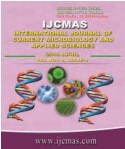


 National Academy of Agricultural Sciences (NAAS)
National Academy of Agricultural Sciences (NAAS)

|
PRINT ISSN : 2319-7692
Online ISSN : 2319-7706 Issues : 12 per year Publisher : Excellent Publishers Email : editorijcmas@gmail.com / submit@ijcmas.com Editor-in-chief: Dr.M.Prakash Index Copernicus ICV 2018: 95.39 NAAS RATING 2020: 5.38 |
The toxic effect of different dietary levels of T-2 toxin on cell-mediated arm of immune system was assessed by eliciting delayed foot web reaction (DFWR) in broiler chicken. The nutritional immunomodulation using arginine (ARG) [22 g/kg] and vitamin E (VE) [80 mg/kg] supplementation was attempted. A total of 144 day old commercial broiler chicks were randomly divided into six groups. The first four groups received 0.0 (Control-Group I), 0.25ppm (Group II), 0.50ppm (Group III) and 1ppm (Group IV) of dietary T-2 toxin. The ARG and VE combination was supplemented in the diet of birds fed either ‘0’ (Group V) or 1ppm (Group VI) of T-2 toxin. The test diets were fed for 0-28 days. The birds were sensitized twice on days 14 and 21 with killed S. aureus antigen and challenged intradermally in toe web on day 28. DFWR was measured at 0, 6, 24, and 48h post challenge. The foot web thickness peaked at 24h post challenge. A significant (P≤0.05) reduction in DFWR was observed in birds fed with 1 ppm of T-2 toxin compared to birds in control as well as ARG and VE supplemented groups. At 0.25 and 0.5 ppm of T-2 toxin, the DFWR was similar to control. The DTH reaction to S. aureus antigen in birds fed 1 ppm of T-2 toxin and supplemented with ARG and VE was similar to control birds. ARG and VE complemented each other to offer immunoprotection to birds that received immunotoxicant T-2 toxin in their diet.
 |
 |
 |
 |
 |